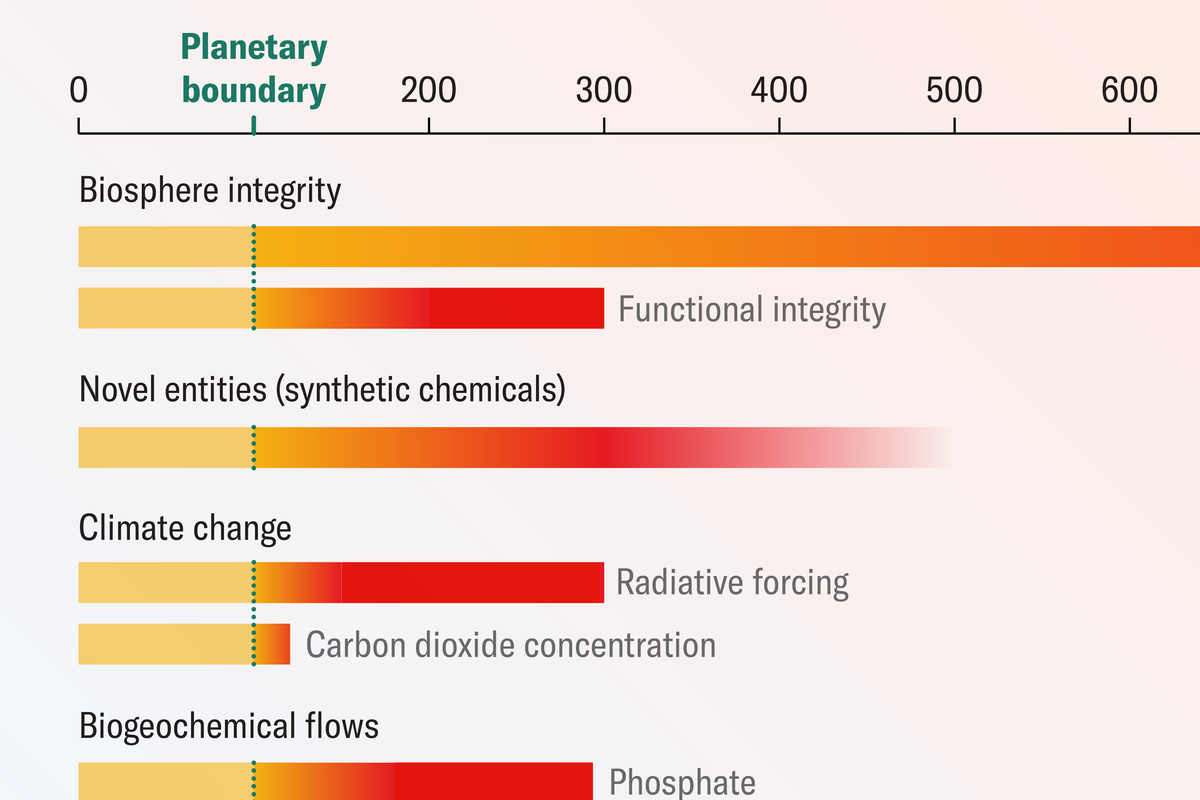
Our planet is sick, and its life-threatening symptoms are getting worse, a new report warns.
Earth has been pushed past multiple physical and chemical boundaries crucial for keeping the world a livable place. Beyond already exceeded thresholds set by scientists for rising temperatures, biodiversity loss and chemical pollution, we have now also breached the boundary on ocean acidification. The milestone comes with grim ramifications for marine ecosystems and human livelihoods.
“More than three-quarters of the Earth’s support systems are not in the safe zone,” Johan Rockström, director of the Potsdam Institute for Climate Impact Research (PIK) in Germany, said in a statement announcing the 2025 evaluation of the planetary boundaries. “Humanity is pushing beyond the limits of a safe operating space, increasing the risk of destabilizing the planet.”
On supporting science journalism
If you’re enjoying this article, consider supporting our award-winning journalism by subscribing. By purchasing a subscription you are helping to ensure the future of impactful stories about the discoveries and ideas shaping our world today.
Humans and many other species evolved to thrive in the climate of the Holocene, a period that began around 10,000 years ago. But as societies industrialized and began widely burning fossil fuels in the 19th century, greenhouse gases built up in the atmosphere, trapping heat and transforming Earth and its climate in many ways besides raising global temperatures.
Beginning in 2009, PIK flagged and prioritized research on nine geophysical limits that make up a sort of planetary life-support system; staying within these limits, they argue, is the best hope for maintaining the clement climatic conditions we and most of Earth’s other denizens have adapted to. In 2023 researchers published a study that quantified those boundaries and established where we are in relation to them. At the time, six of the boundaries had been surpassed, with many well into what the scientists called a “zone of increasing risk.”
“It’s like blood pressure,” said the 2023 study’s lead author Katherine Richardson, an earth systems scientist at the University of Copenhagen, in an interview with Scientific American at the time. “If your blood pressure is over 120 over 80, it’s not a guarantee that you’re going to have a heart attack, but it does raise the risk, and therefore we do what we can to bring it down.”
Among the nine boundaries is of course climate change, which is measured in part by the amount of world-warming carbon dioxide in Earth’s atmosphere. Carbon dioxide concentrations reached a record global high of 422.7 parts per million (ppm) last year, compared with 280 ppm prior to the industrial revolution and the 350 ppm that many scientists consider a “safe” limit (which was surpassed in 1987). The burning of fossil fuels is the indisputable culprit.
Fossil fuels are also behind the new boundary breaching—the ocean absorbs some of the atmosphere’s excess carbon dioxide, causing waters to become more acidic. Since the industrial revolution, the ocean’s surface pH has dropped by 0.1; this may seem minuscule, but because the pH scale is logarithmic, it reflects roughly a 30 percent increase in acidity.
Ocean acidification can have profound impacts on marine ecosystems by depleting seawater of certain carbon compounds that corals and other shell building animals need to construct their protective homes. At low enough pH levels, corals and shells can even begin to dissolve. These effects could destabilize entire ecosystems and devastate many commercially valuable species, such as oysters. A 2020 report by the U.S. National Oceanic and Atmospheric Administration found that ocean acidification would cost the country’s economy billions of dollars.
“The movement we’re seeing is absolutely headed in the wrong direction. The ocean is becoming more acidic, oxygen levels are dropping, and marine heatwaves are increasing. This is ramping up pressure on a system vital to stabilize conditions on planet Earth,” Levke Caesar, co-lead of PIK’s Planetary Boundaries Science Lab, said in the new evaluation’s press statement.
The not-so-short list of other boundaries we’ve blown past is sobering. Excess phosphorus and nitrogen from the widespread use of fertilizers flows into rivers and seas to spark toxic algal blooms. Artificial chemicals, such as plastics, dichlorodiphenyltrichloroethane (DDT) and “forever chemical” perfluoroalkyl and polyfluoroalkyl substances (PFAS) disruptively accumulate in food chains. Agriculture and other changes in land use strip away forests and diminish available fresh water. And as all these problems grow, more and more of Earth’s biodiversity is disappearing.
According to the new report, just two of the nine limits remain intact: ozone depletion and aerosols in the atmosphere. Only the former shows clear progress away from the planetary boundary, as a result of the success of the Montreal Protocol, the international agreement through which countries are phasing out chemicals that erode Earth’s protective ozone layer. Aerosol emissions have declined globally—partly from efforts to reduce pollution from global shipping—but absent any unified policy framework for reductions, levels could easily surge back.
The overall prognosis for the planet’s health is poor, given that a number of countries, including the U.S. in particular, are moving away from meaningful action to tackle environmental problems.
“We are witnessing widespread decline in the health of our planet. But this is not an inevitable outcome. The drop in aerosol pollution and healing of the ozone layer, shows that it is possible to turn the direction of global development. Even if the diagnosis is dire, the window of cure is still open,” Rockström said in the press statement. “Failure is not inevitable; failure is a choice. A choice that must and can be avoided.”



